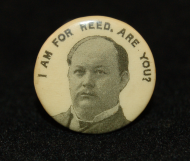What Killed the Political Ribbon?
 /tiles/non-collection/4/4-16-ribbon-2008_067_000-1pq.xml
Darius Hare Campaign Ribbon, Collection of the U.S. House of Representatives
/tiles/non-collection/4/4-16-ribbon-2008_067_000-1pq.xml
Darius Hare Campaign Ribbon, Collection of the U.S. House of RepresentativesAbout this object Was it optimism before the election, or celebration afterwards, that led Darius Hare to print “The Winner” on his ribbons?
Ribbons were first used in American politics in the 1820s. The rise of textile mills and the printing industry made it practical for candidates to print their faces and their taglines on everything from kerchiefs to aprons. Ribbons, however, were cheap to make and easy to carry to campaign events. They quickly became the most popular way for citizens to proclaim their political allegiance.
 /tiles/non-collection/4/4-16-reed-button-2005_096_000-1.xml
Thomas Brackett Reed Campaign Button, 1896, Collection of the U.S. House of Representatives
/tiles/non-collection/4/4-16-reed-button-2005_096_000-1.xml
Thomas Brackett Reed Campaign Button, 1896, Collection of the U.S. House of RepresentativesAbout this object Thomas Brackett Reed, early adopter of celluloid campaign buttons, distributed this example for his 1896 presidential campaign. For ribbons, buttons like this spelled doom.
Then, after generations of success, ribbons met their Waterloo. They were conquered by the celluloid button. In 1896, the Whitehead and Hoag Company patented the button as we know it―paper under celluloid, set in a metal holder with a fastening device. Buttons immediately took off in popularity. They allowed for sharper images, crisper printing, the use of photographs, and they were more durable than ribbons. For a while, ribbon-button combinations were used, but soon the ribbon was relegated to ceremonial occasions.
Sources: Herbert Ridgeway Collins, Threads of History (Washington: Smithsonian Institution Press, 1979); Diane L. Fagan Affleck and Paul Hudon, Celebration and Remembrance: Commemorative Textiles in American, 1790-1990 (North Andover, MA: Museum of American Textile History, 1990); Roger A. Fischer and Edmund B. Sullivan, American Political Ribbons and Ribbon Badges, 1825-1981 (Lincoln, MA: Quarterman Publications, 1981).
Categories:
Art & Artifacts, Elections
Categories
- Announcements
- Art
- Art & Artifacts
- Continental Congress
- Education
- Elections
- Exhibitions & Publications
- Firsts & Milestones
- Holidays
- House Chamber
- House Pages
- House Practice & Traditions
- Institution
- Legislation
- Minorities in Congress
- Opening Day
- Oral History
- People
- Photography
- Presidents
- Rankin Centennial
- Records & Research
- Speakers of the House
- State of the Union
- War
Authors
Blog Roll
Monthly Archive
- 2016
- 2015
- 2014
- 2013
- 2012


